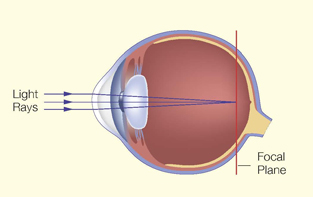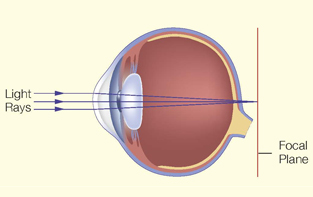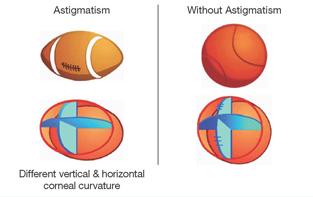About Eye Diseases  Paediatric Eye Diseases
Paediatric Eye Diseases
Refractive Error in Children
Newborn infants are able to see. Their visions continue to develop over the first 8 years of life. Any eye problem occurring during this crucial period of time may hinder the proper development of the eye. If left neglected, this will lead to lazy eye (amblyopia) or other irremediable outcomes.
Normal

Nearsightedness (Myopia)

In Hong Kong, more than 40% of primary school children suffer from nearsightedness. Nearsightedness is due to the eyeball being too long, and it usually increases as the child grows until after adolescence when the eye reaches a stable length.
A child with nearsightedness typically complains of blurry vision for distant objects. The child will have difficulty in reading the writing board and may squint his/her eyes when looking at distant objects.
If a child has significant nearsightedness, spectacles should be used to improve vision as well as prevent lazy eye.
Farsightedness (Hyperopia)

Farsightedness is less common than nearsightedness amongst Hong Kong children, and it is due to the eyeball being too short. Farsightedness usually decreases as the eyeball grows and its symptoms are less obvious than nearsightedness. If a child only has mild farsightedness (less than 2D or 200 degrees), the elasticity of the lens helps to keep things in focus and he/she can see rather clearly. However, if the child has severe farsightedness, he/she will have difficulty in focusing and thus will see poorly. The child may even develop squint (strabismus) and lazy eye. Under these circumstances, the child must wear glasses.
Astigmatism

In astigmatism, the curvature of the cornea is different along different axes. As a result, light rays entering the eye are focused at different points instead of a single point. This will create a blurry image. The child may suffer from eyestrain, squint the eyes or adopt a head tilt. A child with severe astigmatism requires glasses.
Strabismus (Squint)
Strabismus is a condition in which the two eyes point towards different directions. One eye is fixed at the object of interest, while the other eye is misaligned inwards (convergent squint), outwards (divergent squint) or upwards/downwards (vertical squint). A child with squint will only use the properly aligned eye to see and the image of the other eye will be suppressed. This will lead to loss of binocular vision and may even develop lazy eye. Squint may also affect the child’s self- esteem and hinder his/her social development because of cosmetic issue.
In most cases, squint is due to imbalance of the muscles of the eyeball. However, in a small number of children, squint is caused by serious underlying eye diseases such as congenital cataract, eye cancer, etc. Therefore, we should never neglect a squint.
Besides, many people confuse “pseudo squint” with “true squint”. In a child with pseudo squint, his/her eyes are actually normal and are well aligned. However, a wide and flat nose bridge gives the illusionary appearance of crossed eyes. As he/she grows older and the nasal bridge becomes higher, it gives a perception that the squint has improved.
In a child with true squint, the eyes are misaligned and the condition will not improve as he/she grows. He/she needs early treatment to realign the eyes and allow normal vision to develop. Treatment of squint includes the use of glasses, patching, visual training and surgery. Lazy Eye (Amblyopia)
During the first 8 years of life, the visual system is in a developmental stage. If visual function of the eye is hindered at this stage, the vision will not develop properly, and it will become a lazy eye.
Lazy eye commonly occurs in only one eye of a child, the cause can be squint, strong degree of refractive error in one eye, droopy eyelid, or eye diseases like cataract. It causes the child to rely on the better eye to see. As the signs are usually inapparent, parents might not be aware that their child has lazy eye unless they bring their child for a formal eye examination. After the age of 8, lazy eye becomes irreversible and is not correctable with the use of glasses. If detected in early childhood, lazy eye can be corrected by patching the normal eye.
Eye Examination
A young child will not be able to tell you of his/her visual
problems. Therefore, parents should bring their child
for eye examination. A comprehensive eye examination
not only tell you whether the child has nearsightedness,
farsightedness, astigmatism, squint, or lazy eye, it can
also reveal other eye diseases such as congenital
cataract, which can receive early treatment once
detected. If the eyes are found to be normal, this will
form a baseline for future reference.
An eye doctor is able to examine a child of any age and also check whether the child has any focusing problems. For infants, the eye doctor may need to use special techniques, instruments or diagnostic eye drops / medications.
We recommend every child to have an annual comprehensive eye examination after the age of 4. If you notice any of the following conditions, you should bring the child to see an eye doctor as soon as possible even before the age of 4:
Newborn infants are able to see. Their visions continue to develop over the first 8 years of life. Any eye problem occurring during this crucial period of time may hinder the proper development of the eye. If left neglected, this will lead to lazy eye (amblyopia) or other irremediable outcomes.
Normal

Nearsightedness (Myopia)

In Hong Kong, more than 40% of primary school children suffer from nearsightedness. Nearsightedness is due to the eyeball being too long, and it usually increases as the child grows until after adolescence when the eye reaches a stable length.
A child with nearsightedness typically complains of blurry vision for distant objects. The child will have difficulty in reading the writing board and may squint his/her eyes when looking at distant objects.
If a child has significant nearsightedness, spectacles should be used to improve vision as well as prevent lazy eye.
Farsightedness (Hyperopia)

Farsightedness is less common than nearsightedness amongst Hong Kong children, and it is due to the eyeball being too short. Farsightedness usually decreases as the eyeball grows and its symptoms are less obvious than nearsightedness. If a child only has mild farsightedness (less than 2D or 200 degrees), the elasticity of the lens helps to keep things in focus and he/she can see rather clearly. However, if the child has severe farsightedness, he/she will have difficulty in focusing and thus will see poorly. The child may even develop squint (strabismus) and lazy eye. Under these circumstances, the child must wear glasses.
Astigmatism

In astigmatism, the curvature of the cornea is different along different axes. As a result, light rays entering the eye are focused at different points instead of a single point. This will create a blurry image. The child may suffer from eyestrain, squint the eyes or adopt a head tilt. A child with severe astigmatism requires glasses.
Strabismus (Squint)
Strabismus is a condition in which the two eyes point towards different directions. One eye is fixed at the object of interest, while the other eye is misaligned inwards (convergent squint), outwards (divergent squint) or upwards/downwards (vertical squint). A child with squint will only use the properly aligned eye to see and the image of the other eye will be suppressed. This will lead to loss of binocular vision and may even develop lazy eye. Squint may also affect the child’s self- esteem and hinder his/her social development because of cosmetic issue.
In most cases, squint is due to imbalance of the muscles of the eyeball. However, in a small number of children, squint is caused by serious underlying eye diseases such as congenital cataract, eye cancer, etc. Therefore, we should never neglect a squint.
 Convergent Squint |
 Divergent Squint |
 Vertical Squint |
Besides, many people confuse “pseudo squint” with “true squint”. In a child with pseudo squint, his/her eyes are actually normal and are well aligned. However, a wide and flat nose bridge gives the illusionary appearance of crossed eyes. As he/she grows older and the nasal bridge becomes higher, it gives a perception that the squint has improved.
In a child with true squint, the eyes are misaligned and the condition will not improve as he/she grows. He/she needs early treatment to realign the eyes and allow normal vision to develop. Treatment of squint includes the use of glasses, patching, visual training and surgery. Lazy Eye (Amblyopia)
During the first 8 years of life, the visual system is in a developmental stage. If visual function of the eye is hindered at this stage, the vision will not develop properly, and it will become a lazy eye.
Lazy eye commonly occurs in only one eye of a child, the cause can be squint, strong degree of refractive error in one eye, droopy eyelid, or eye diseases like cataract. It causes the child to rely on the better eye to see. As the signs are usually inapparent, parents might not be aware that their child has lazy eye unless they bring their child for a formal eye examination. After the age of 8, lazy eye becomes irreversible and is not correctable with the use of glasses. If detected in early childhood, lazy eye can be corrected by patching the normal eye.
 Normal Vision |
 Amblyopic Vision |
Eye Examination
 Squint Assessment |
 Assessment of Stereopsis |
An eye doctor is able to examine a child of any age and also check whether the child has any focusing problems. For infants, the eye doctor may need to use special techniques, instruments or diagnostic eye drops / medications.
We recommend every child to have an annual comprehensive eye examination after the age of 4. If you notice any of the following conditions, you should bring the child to see an eye doctor as soon as possible even before the age of 4:
- An infant who has abnormal visual response, e.g. he/ she does not respond to light or follow toys, cannot recognize the face of his/her parents, etc.
- The eyes have abnormal appearance, e.g. droopy eyelids, redness and swelling of the eyes, bulging eyeballs, or white reflection from the pupils, etc.
- Frequent blinking, rubbing of eyes, or tearing
- Blurred vision, double vision
- Abnormal alignment of eyes, e.g. eye turned inwards, outwards or upwards
- Head tilt when looking at objects
- Squinting of eyes when looking at objects or when copying from the writing board
- Any other conditions that make you worried
 Droopy Eyelid |
 Congenital Cataract |
 Head Tilt Caused by Vertical Squint |
 Treatment of Lazy Eye with Occlusion |
